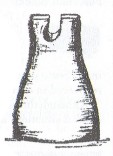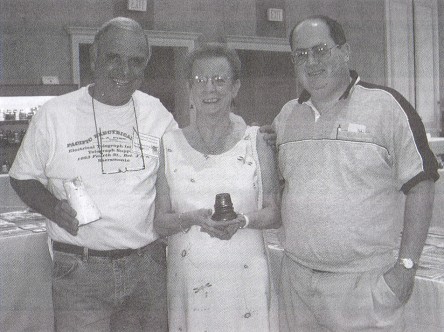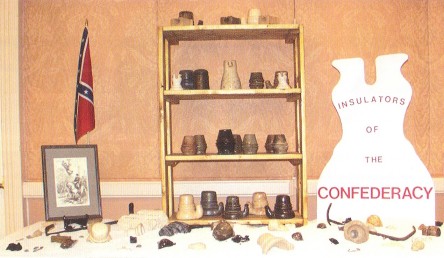Insulators of the Confederacy
Reprinted from "Crown Jewels of the Wire", September 2001, page 15
Display by:
Doug MacGillvary
79 New Bolton Road
Manchester, CT 06040-3722
860-649-04,77
veryoldmud@home.com
WINNER:
Dr. Fredrick Griffin Memorial Award
presented by the N.I.A. for
Threadless
People's Choice Award (DJIC)
The theme of this display is adapted from a similar display presented by the
late Dr. Fred Griffin at the 5th National Insulator Show in Hershey,
Pennsylvania, June 29-30, 1974.
It was at that show that I met Fred, swapped
insulators with him and admired the outstanding display of threadless insulators
that he had put together. Fred's display won the Cross Arms Ribbon as the best
threadless display and was featured on the cover of Crown Jewels of the Wire
magazine of September 1974. It was Fred's love of threadless that resulted in
the National Insulator Association naming its award for best exhibit of
threadless insulators at each National Show in his honor.
One third of the
recognized styles of porcelain threadless insulators were used, or at least
thought to be used, by the Confederate troops during the Civil War. Several
styles of glass insulators were thought to have been used by the Confederacy, as
well. This display only showcases what is probably the most popular glass
threadless: "The Confederate Egg".
Confederate Egg - CD 701.6 and U-970 - Virginia Glass Manufacturing Co.,
Richmond, Virginia

The site of this glass company at the corner of Main and Tyler Streets in
Rocketts, Richmond, Virginia, was in earlier years (mid-1850s) referred to as
the "Richmond Glass Works". The incorporation of the Virginia Glass
Manufacturing Co. took place on February 19, 1858. Jacob Atlee, the proprietor of the works, was very active in the
production of various types of bottles and jars.
Advertisements from 1857 and
1858 list several types of bottles and flasks. While insulators are not
mentioned, it is apparent Atlee was involved with their production. During the
Civil War, Atlee was charged and later acquitted for "supposed
disloyalty". Mr. Atlee became involved in these charges partly through his
endeavor to procure soda ash and a particular kind of clay, essential to the
manufacture of telegraph wire insulators. Soda ash was one of several
ingredients used in glassmaking.
The clay referred to was also most likely to
have been used in the manufacture of glass, although one could speculate that it
might have been used in the making of porcelain insulators. An 1858 issue of the
Richmond Dispatch made mention that Mr. Atlee had established a pottery in
Richmond.
Because portions of glass eggs of the CD 701.6 style have been
recovered at the site of the Virginia Glass Mfg. Co., it would stand to reason
that at least some of these egg-style insulators that were used in the Southern
states were produced at the Richmond factory. This would be especially true
during the Civil War, when the supply of goods from the North was interrupted.1
There have been at least three porcelain threadless insulators, similar to the
glass egg, and all were found in the Richmond, Virginia vicinity.2 They were
apparently made at Parr's Pottery Works in Richmond in 1861, and were used on a
telegraph line that ran from Richmond to Yorktown, Virginia.3
U-973

This piece remains one of the mystery insulators. It appears to be a
variant of the U-970. It also has its roots in the South and might have been a
piece used by the Confederacy. This, of course, is just an assumption. To date,
this is the only example of a U-973 known to exist. The first time I remember
seeing this insulator was in Fred Griffin's Threadless Display at the National
Show in Berea, Ohio in 1976.
U-984

"Jim Meyer reported two U-984s. This is a very unusual insulator in that
it is nearly an exact duplicate of the glass CD 127. U-984 is made of pottery
material, similar to most of the threadless "porcelain" insulators
from the 1850s to 1870s. The glaze is crude dark tan. Jim says that he bought
two of these in a collection. The original owner bought them from a diver who
found them in Mobile Bay in Alabama. They were found around 1970. Jim thinks
that they may be English insulators. He has copies of original bills of lading
that show that the Confederacy imported insulators through an agent that was
based in Bermuda.
Jim says that he also collects bottles and English stoneware,
but the glaze on these insulators looks much different than any English
stoneware that he has seen. Jim suspects that they were Confederate copies of
English stoneware insulators, since the glaze is similar to the stoneware pieces
made during the Civil War period in the South."4
U-988

The porcelain "Slash Top" threadless was said to have been used on
Confederate telegraph lines during the Civil War. The origin of this unique
insulator was right here in Georgia.
Following are excerpts from Crown Jewels of the Wire magazine, February 1976 issue, "Porcelain Insulator News"
column by Jack H. Tod: "These insulators have a white glaze, a shiny white but rather blanche as with old
porcelain door knobs. The body material is a very good quality clay -- possibly
as good as pure "Kaolin" china clay. The U-988 was made in a two part
mold.
"Although very well made for the purpose intended and considerably
better made than "pottery" threadless insulators of that era, there
are the expected signs of the crudeness consistent with the handwork involved of
pin holes, bases out of round and some that have a slight tip.
"The U-988
is a cute little insulator, an unusual design with a glass counterpart, and it
has indisputable historical significance."
U-989
|
SLASH TOP PORCELAIN THREADLESS |
|

|
Found: Blakely River (across from Mobile) while scuba diving
Used: On a
Confederate telegraph line during the Civil War.
Color: Cream color with faint
overtones or specks of light brown
|
Small notched-in groove running around top.
The curve on the outside of the
slash goes the opposite way on the other side.
Peculiar shape to the
slash-narrow in the middle and then flares out at each end, and also flares out
to nothing. |
MEASUREMENTS:
Height 5-7/6"
Base diameter 3-3/4"
Top diameter 2
x 2-1/4"
Pin hole diameter 1-3/8"
Depth of groove in middle
15/16"
Depth of groove in outside 1-1/4" |

|
For several years I have known of
the threadless "slash top" porcelain insulator that was found by Dr.
Phillips of Mobile, Alabama. This one was found along with glass ones, of the
"tea pot" shape, and other threadless insulators. Having never gotten
into that area, I have not had the pleasure of seeing it.
Now through the
efforts of Robert Hanan of Mobile, and by the courtesy of Dr. and Mrs. Phillips,
I have a sketch by Mr. Hanan, which is shown here, The information below is also
given by Mr. Hanan.
Quote by Hanan, "The threadless pin hole has an interesting groove, running all the way through, from the bottom to the top. It
is 3/16" in diameter and about 1/16" deep. I have never seen a groove
like this in a threadless insulator. The reason for the groove is unclear.
However, several glass threadless insulators have been dug in the Mobile area
complete with fragments of the original pin embedded in the insulator. These
pins are invariably wrapped with canvas or heavy cloth where they fit into the
hole. Perhaps the groove in the slash top was for the purpose of catching or
wedging the cloth to keep the insulator from twisting and falling off the pin.
This is, of course, just a supposition on my part, but I pass it along for what
it is worth."5
U-990

These are the "Teapots"! Gerald Brown wrote: "This insulator
seems to me, to be the most interesting and among the rarest of all the
porcelains that have been found." Although not the rarest anymore, it is
still the most interesting. I have several, of which no two come close to
another in color. There are two sizes: the larger is 4-3/8" in diameter and
the smaller is 3-7/8" in diameter.
Jack Tod referenced the following to the
1939 book "Marketing Burned Clay Products:, by A. Hamilton Chute: "A pottery in Kaolin, SC during the War,
made porcelain and pottery insulators for use on the Confederate Telegraph
Line." Jan then mused that "some of you insulator buffs should try out
the dump digging in Kaolin. Wow, just the thought of finding that one!" That
was in 1975.
In the February 1997 issue of Crown Jewels of the Wire magazine,
Dick Bowman proclaimed, "It is a mystery no more!" The Southern
Porcelain dump had been located and dug. The unglazed U-990 "Teapot"
and porcelain block and examples of the specimens dug at the recently discovered
site. The U-989 has also been linked to the Southern dig.
Porcelain Blocks

At the Southern Porcelain Co. site in Kaolin, SC, many
porcelain blocks were recovered. Most of them, apparently rejected for various
reasons, were unglazed. Many had scribed lines, crosses, and even numbers on
them, indicating some sort of identification process, possibly slave markings.
Some pieces of glazed blocks were found and at least two glazed examples were
recovered in excellent condition.
Although the block insulator had given way to
the pin style, its practicality for use in combat situations apparently made it
a popular insulator with the Confederate telegraphers.

No one could be happier than Doug MacGillvary to have added a U-989 (in
Doug's hand) to his collection at the show. But when 70's collector Peg Hotten
and her son Erik arrived with another threadless "hat", a piece
purchased from a farmer in New York state for (Well, let's say less than a
dollar!), Doug was ecstatic.
(Information compiled by Doug MacGillvary for display handout.)

Insulators of the Confederacy by Doug MacGillvary
Dr. Fredrick Griffin
Memorial Award presented by the N.I.A. for Threadless
People's Choice Award (DJIC)
| 